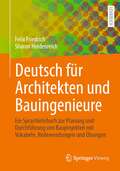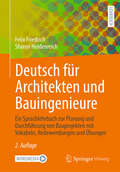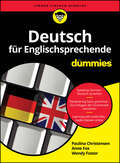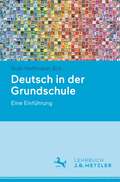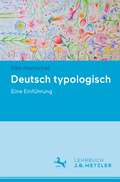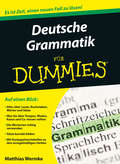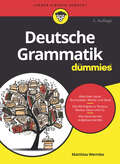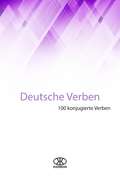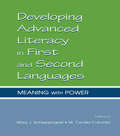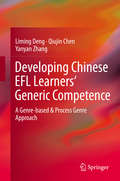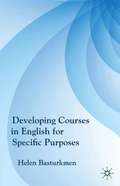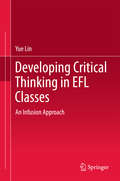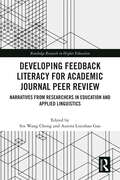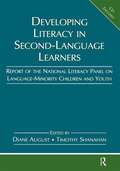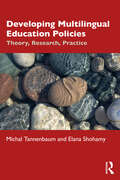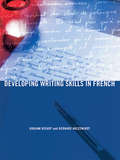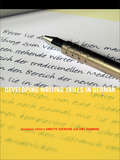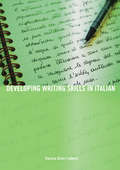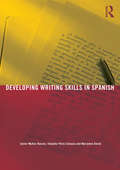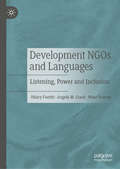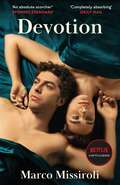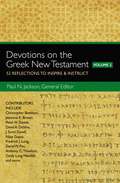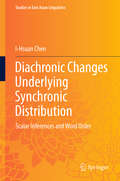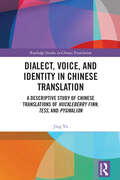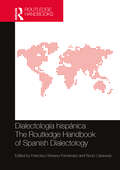- Table View
- List View
Deutsch für Architekten und Bauingenieure: Ein Sprachlehrbuch zur Planung und Durchführung von Bauprojekten mit Vokabeln, Redewendungen und Übungen
by Sharon Heidenreich Felix FriedrichEin Sprachlehrbuch, das speziell für Architekten, Bauingenieure und verwandte Berufsgruppen aller Nationalitäten konzipiert ist, die ihre deutsche Kommunikationsfähigkeit im beruflichen Kontext verbessern wollen. Das Buch kann sowohl für das Selbststudium als auch kursbegleitend eingesetzt werden. Nachdem in der 1. Hälfte des Buches viele Grundlagen der Bauwirtschaft behandelt werden, orientiert sich die 2. Hälfte an den Leistungsphasen und der Abwicklung von Beispielprojekten. Pro Kapitel werden Fachvokabular, Redewendungen, Kommunikationsformen und auch Grammatik vermittelt. Übungen und Aufgaben mit Lösungen runden das Werk ab.Nach dem Gemeinsamen europäischen Referenzrahmen (GER) für Sprachen entspricht das Lehrwerk einem Niveau von B2/C1.
Deutsch für Architekten und Bauingenieure: Ein Sprachlehrbuch zur Planung und Durchführung von Bauprojekten mit Vokabeln, Redewendungen und Übungen
by Sharon Heidenreich Felix FriedrichEin Sprachlehrbuch, das speziell für Architekten, Bauingenieure und verwandte Berufsgruppen aller Nationalitäten konzipiert ist, die ihre deutsche Kommunikationsfähigkeit im beruflichen Kontext verbessern wollen. Das Buch kann sowohl für das Selbststudium als auch kursbegleitend eingesetzt werden. Nachdem in der 1. Hälfte des Buches viele Grundlagen der Bauwirtschaft behandelt werden, orientiert sich die 2. Hälfte an den Leistungsphasen und der Abwicklung von Beispielprojekten. Pro Kapitel werden Fachvokabular, Redewendungen, Kommunikationsformen und auch Grammatik vermittelt. Übungen und Aufgaben mit Lösungen runden das Werk ab. Neu in der 2. Auflage: Alle Dialoge stehen als Audiodateien zur Verfügung. Durch QR-Codes im Buch können diese abgerufen und direkt angehört werden. Nach dem Gemeinsamen europäischen Referenzrahmen (GER) für Sprachen entspricht das Lehrwerk einem Niveau von B2/C1.
Deutsch für Englischsprechende für Dummies
by Paulina Christensen Anne Fox Wendy FosterWenn es mehr als »Guten Tag« sein soll »Deutsch für Englischsprechende« bietet einen leichten Einstieg in die deutsche Sprache. Das Buch ist in Englisch geschrieben. Hier lernen Sie alles Wissenswerte zur deutschen Grammatik und zur Konjugation der Verben. Und die Downloaddateien mit Dialogbeispielen aus dem richtigen Leben helfen Ihnen, die Aussprache zu erlernen. »German for Dummies« offers an easy introduction to the German language for English speakers. You will learn the essentials you need to know about grammar and verb conjugation. And the download files with real-life dialog examples will help you learn the pronunciation. Sie erfahren Wie Sie im Deutschen richtig betonen - How to emphasize German words correctly Wie Sie sich auf Deutsch zurechtfinden - How to find your way around in German Wie Sie deutsche Redewendungen richtig benutzen - How to use German idioms correctly
Deutsch in der Grundschule: Eine Einführung
by Ruth Hoffmann-ErzDiese Einführung verbindet Themen der Sprachwissenschaft und der Sprachdidaktik und ist speziell auf das Grundschullehramtsstudium Deutsch zugeschnitten. Fachwissenschaftliche Kapitel zu Semiotik, Phonologie, Graphematik, Textlinguistik, Grammatik sind verzahnt mit fachdidaktischen Kapiteln zu Sprechen und Zuhören, Schriftspracherwerb, Lese- und Rechtschreibdidaktik, Texte verfassen und Sprache untersuchen. So wird die Relevanz fachwissenschaftlicher Inhalte für die Lehrerprofessionalisierung ersichtlich. Der Band ist auch für die Fort- und Weiterbildung zu empfehlen. – Im zweifarbigen Layout, mit Definitionen, Beispielen und Aufgaben.
Deutsch typologisch: Eine Einführung
by Elke HentschelTypologie als die Einteilung von Untersuchungsgegenständen nach Typen basiert von Fach zu Fach auf unterschiedlichen Typen-Definitionen, die auch innerhalb eines Fachgebiets variieren können. In der Linguistik finden sich spezifische typologische Ansätze in den verschiedensten Teilgebieten, von der Lautlehre bis zur Dialektologie. Der Schwerpunkt der linguistischen Typologie und damit auch dieser Einführung liegt in den Bereichen Morphologie und Syntax. Im Mittelpunkt steht dabei das Deutsche, das anhand zahlreicher Beispiele im Kontext anderer Sprachen betrachtet wird.
Deutsche Grammatik für Dummies (Für Dummies)
by Matthias WermkeIhr Wegweiser durch den Dschungel der deutschen Grammatik Mögen Sie Grammatik? Nein? Grämen Sie sich nicht. Sie sind nicht allein. Irgendwann wurden wir alle mit der Grammatik des Deutschen geplagt. Wir mussten Wörter rauf- und runterdeklinieren, absonderliche Verbformen bilden, Schachtelsätze in ihre Einzelteile zerlegen und nach Satzbausteinen suchen, die uns überhaupt nicht interessierten. Grammatik kann zwar wirklich ätzend sein, nützlich ist sie gelegentlich aber auch. Und damit die deutsche Grammatik für Sie eher nützlich als ätzend ist, finden Sie in diesem Buch die wichtigsten Themen leicht verständlich erklärt, jede Menge Beispiele, die Ihnen die Regeln veranschaulichen und viel Wissenswertes rund um die deutsche Grammatik und deren Bedeutung. Für den schnellen Überblick gibt es zahlreiche Tabellen. So verlieren die vielen Regeln ihren Schrecken und werden auch für Grammatikmuffel leicht verständlich.
Deutsche Grammatik für Dummies (Für Dummies)
by Matthias WermkeMögen Sie Grammatik? Nein? Keine Sorge, damit sind Sie nicht allein. Die deutsche Sprache kann ganz schön kompliziert sein. So schwierig Grammatik ist, so nützlich ist sie aber gelegentlich auch. Und damit die deutsche Grammatik Ihnen ganz bestimmt kein Kopfzerbrechen mehr bereitet, finden Sie in diesem Buch die wichtigsten Aspekte leicht verständlich erklärt. Zahlreiche Beispiele veranschaulichen die einzelnen Regeln und nebenbei lernen Sie jede Menge Wissenswertes rund um die deutsche Grammatik und ihre Bedeutung. So verlieren die vielen Regeln ihren Schrecken und werden auch Grammatikmuffeln leicht verständlich.
Deutsche Verben (100 konjugierte Verben)
by Editorial KaribdisNachschlagewerk zur Konjugation der 100 wichtigsten Verben im Deutschen, besonders geeignet für elektronische Geräte. Zunächst wird in der Einleitung die Bildung aller deutschen Tempora erklärt, im Anschluss wird die Konjugation von 100 wichtigen Verben vorgestellt. Das Buch ist ohne Bildmaterial konzipiert, damit der Leser leicht entsprechende Textstellen finden kann.
Developing Advanced Literacy in First and Second Languages: Meaning With Power
by Mary J. Schleppegrell M. Cecilia ColombiThis book addresses the linguistic challenges faced by diverse populations of students at the secondary and post-secondary levels as they engage in academic tasks requiring advanced levels of reading and writing. Learning to use language in ways that meet academic expectations is a challenge for students who have had little exposure and opportunity to use such language outside of school. Although much is known about emergent literacy in the early years of schooling, much less has been written about the development of advanced literacy as students move into secondary education and beyond. Developing Advanced Literacy in First and Second Languages: Meaning With Power: *brings together work on first and second language acquisition and emphasizes the importance of developing advanced literacy in the first language, such as Spanish for bilingual students, as well as English; *spans a range of theoretical orientations and analytic approaches, drawing on work in systemic functional linguistics, genre theory, and sociocultural perspectives; *addresses the content areas of science, history, and language arts; *provides specific information about genres and grammatical features in these content areas; and *presents suggestions for teacher education. What unites the contributors to this volume is their shared commitment to a view of literacy that emphasizes both the social contexts and the linguistic challenges. The chapters collected in this volume contribute in important ways to research and pedagogy on advanced literacy development for the multilingual and multicultural students in today's classrooms. This book is particularly useful for researchers and students in language and education, applied linguistics, and others concerned with issues and challenges of advanced literacy development in first and second languages.
Developing Chinese EFL Learners' Generic Competence
by Liming Deng Qiujin Chen Yanyan ZhangThis work investigates the development of English as a Foreign Language (EFL) learners' generic competence in reading, writing and translation within the particular Chinese classroom context. It provides a new perspective for the current teaching and research in reading, writing, translation within the EFL contexts and offers an insightful framework for pedagogical applications in language learning and teaching. Its findings will be extremely valuable not only in local situations, but also more generally in a wider regional and global context as well. The book employs a series of research tools, including pre-research and post-research questionnaires, pre-test and post-test of reading/writing/translation, multi-faceted writing portfolios (including reflection reports), textual analysis and in-depth interviews. It involves 209 participants from a primary university in Wuhan, among whom 171 are undergraduates and 38 are postgraduates. And it draws on the analysis of such varied multi-sourced data both qualitatively and quantitatively. Genre-based teaching is playing a critical role in initiating EFL learners into the discourse community of the target language. Developing EFL learners' generic competence is viewed as the ultimate goal in the process of teaching and learning. This monograph effectively demonstrates that like genre-based English for Specific Purposes (ESP) pedagogies, it is also possible to take advantage of already acquired genre knowledge for use in EFL learning contexts. It offers an impressive view of the direction in which genre-based applications are likely to take in the coming years.
Developing Courses in English for Specific Purposes
by Helen BasturkmenPresented in two parts, this book firstly introduces core considerations in ESP course development drawing on examples from a wide range of ESP and EAP courses. Secondly four case studies show how experienced ESP teachers and course developers went about developing courses to meet the needs of their particular learners.
Developing Critical Thinking in EFL Classes: An Infusion Approach
by Yue LinThis book presents an innovative teaching experiment and an analytical study of critical thinking and the sociocultural theory of learning to illustrate the cognitive learning development mechanisms. It addresses the issues in developing critical thinking, including the controversy surrounding the definition, measurement and teaching of critical thinking, particularly in the L2 context.The book explains how infusion-thinking lessons can be structured to help students develop critical thinking along with language learning. Further, it uses a case study as a real-world example to examine the applicability and feasibility of infusion-thinking lessons in the EFL context and their effectiveness in developing students’ critical thinking and language learning.Packed with thinking activities and techniques, this practical, hands-on manual provides original ideas and empirical data, giving teachers everything they need to plan their lessons to improve students’ critical thinking within language courses and evaluate their teaching.
Developing Feedback Literacy for Academic Journal Peer Review: Narratives from Researchers in Education and Applied Linguistics (Routledge Research in Higher Education)
by Sin Wang Chong Aurora Lixinhao GaoThis edited volume showcases first-hand accounts of crafting and handling feedback during the peer review process from early career researchers (ECRs), journal editors and experienced reviewers to develop the concept of ‘feedback literacy’ in academic peer review contexts.This novel collection of research uses personal reflections, disseminations of good practices, research syntheses and small-scale primary studies to highlight implications for feedback practices, demonstrating how academics’ capacity, disposition and skills in providing and engaging with constructive, professional and actionable feedback are crucial to ensure a comprehensive and worthwhile process. Chapters draw attention to the need for academics to develop feedback literacy, both at the ECR level and for more experienced peer reviewers, journal editors and authors, furthering discussion on improvement strategies and solutions to current feedback practices.Reimagining journal peer review as an inclusive and sustainable participatory system, this book will appeal to scholars and researchers working in higher education and educational assessment. There will be particular interest among postgraduate students and ECRs across the Arts, Humanities and Social Sciences disciplines for whom journal peer review has a particular relevance.
Developing Literacy in Second-Language Learners: Report of the National Literacy Panel on Language-Minority Children and Youth
by Timothy Shanahan Diane AugustThis volume reports the findings of the National Literacy Panel on Language-Minority Children and Youth. The formal charge to the panel—a distinguished group of expert researchers in reading, language, bilingualism, research methods, and education—was to identify, assess, and synthesize research on the education of language-minority children and youth with respect to their attainment of literacy. Funding for the project was provided to the Center for Applied Linguistics and SRI International by the U.S. Department of Education’s Institute of Education Sciences and the Office of English Language Acquisition, with additional funding from the National Institute of Child Health and Human Development provided through the U.S. Department of Education. The authors review the state of knowledge on the development of literacy in language-minority children and youth, organized around five specific themes:*Development of Literacy in Second-Language Learners;*Cross-linguistic Relationships in Second-Language Learners;*Sociocultural Contexts and Literacy Development*Educating Language-Minority Students: Instruction and Professional Development; and*Student Assessment Each part begins with a synthesis chapter that spells out the research questions for the chapters in that part, provides background information, describes the methodology used, summarizes the empirical findings reported, addresses methodological issues, and makes recommendations for future research. The following chapters provide more detail on the individual studies reviewed for specific research questions. The volume includes two opening chapters, “Introduction and Methodology” and “Demographic Overview”; a closing chapter that summarizes the report, identifies cross-cutting themes, and makes recommendations for future research; and a CD-ROM providing a searchable database of research references. The audiences for this volume include researchers interested in the development of literacy in language-minority children and youth as well as those studying literacy more generally, and those concerned with improving the education of this population of students.
Developing Multilingual Education Policies: Theory, Research, Practice
by Elana Shohamy Michal TannenbaumMultilingual policies are increasingly important and required in educational settings worldwide, yet a solid experimental body of theory, research, and practice providing guidance for the development of policies is lacking. The Israeli context presented in this book serves as a case study or a model that could be used by bodies or entities seeking to devise a multilingual policy. The authors begin by addressing the general notion of a multilingual education policy with specific reference to the Israeli context. The book then focuses on specific challenges confronting the new policy that have been explored in empirical studies, and concludes with a proposed framework for a new multilingual education policy related to the core theoretical topics and empirical findings discussed in the previous chapters. This framework includes principles and strategies for implementing the process described in the book in other contexts, ensuring wide applicability and relevance. Developing Multilingual Education Policies: Theory, Research, Practice is an essential read for all involved in language policy and planning within applied linguistics and education.
Developing Writing Skills in French
by Graham Bishop Bernard HaezewindtDesigned for intermediate to advanced students, this text equips readers with the necessary skills to write confidently in French in a range of situations. Suitable for use as a classroom text or as a self-study course, it is carefully structured to ensure a better understanding of the effect of choice of words, register and style.Each chapter contains a selection of model texts, activities and clear notes on the format, style and language demonstrated. Every activity also has a model answer in the key, which also offers advice, explanations and further examples to support the student's learning. Features include:* key learning points clearly indicated at the beginning of each chapter* a rich selection of model texts from a variety of different media.Based on a well-reviewed Open University course and written by experienced teachers of the language, Developing Writing Skills in French has been trialled with non-native speakers of French to produce a valuable resource that will help students write appropriately for a variety of contexts.
Developing Writing Skills in German
by Annette Duensing Uwe BaumannDeveloping Writing Skills in German, is a unique course designed to improve the reading and writing skills of intermediate students of German. Presenting a wide range of authentic written materials, the book aims to develop reading strategies and the ability to write texts of various types - essays, articles and reviews - while imparting an understanding of important aspects of German society. From the environment to consumerism, each chapter focuses on a different theme and concentrates on the advancement of particular skills; all the chapters conclude with a task appropriate to the skills focus of the section. Summary writing, note-taking, the use of mind-maps to collect ideas, and other strategies for successful writing in German are presented here. This course is suitable both for classroom use and independent study, with feedback and answer key supplied at the back of the book.
Developing Writing Skills in Italian (Developing Writing Skills)
by Theresa Oliver-FedericiDeveloping Writing Skills in Italian has been specifically designed for upper-intermediate students of Italian who need to write Italian for personal, business and academic purposes. With a strong focus on writing as a meaningful and valuable skill in itself, Developing Writing Skills in Italian supports the learner throughout the process of writing, from the planning and drafting stages to the revising and editing of a final version, enriching and extending the learners’ lexical, grammatical and communicative writing skills. Divided into four logically structured sections the learner can work through a range of realistic and contextualized writing tasks which will allow them to master a variety of styles, registers and formats. Features include: flexible structure a summary of learning points clearly indicated at the beginning of each chapter focus on self assessment, allowing students to engage fully in the writing process by evaluating their own work a glossary of key phrases and useful vocabulary. This course is suitable both for classroom use and independent study. Assessment guides, a teacher’s guide, answer key and supplementary activities are all available on the accompanying website.
Developing Writing Skills in Spanish (Developing Writing Skills Ser.)
by Javier Muñoz-Basols Marianne David Yolanda Pérez SinusíaDeveloping Writing Skills in Spanish provides intermediate and advanced level students with the necessary skills to become competent and confident writers in the Spanish language. With a focus on writing as a craft, Developing Writing Skills in Spanish offers a rich selection of original materials including narrative texts, expository essays, opinion pieces and newspaper articles. Each chapter covers a specific kind of writing and is designed to help tackle the material in small units. The book aids students in crafting clear, coherent and cohesive manuscripts by means of guided practice and step-by-step activities. Key features: Guidance on how to structure a variety of texts: narrative, descriptive, expository, argumentative, academic, journalistic, legal and scientific. Sequenced exercises on style, writing conventions, word choice, syntax and grammar. Reference lists and tables with specialized vocabulary, transition words and other useful expressions. Strategies and tips for planning manuscripts, brainstorming ideas, vocabulary enrichment, editing and proofreading. Includes original samples, as well as fragments from newspapers, well-known literary works and essays by notable Hispanic authors and journalists. Website with additional activities to reinforce the content of each chapter and a teacher's guide with valuable support materials at: www.developingwritingskills.com Designed as a classroom text, self-study material or simply as a resource on writing, Developing Writing Skills in Spanish is the ideal supplement for all intermediate to advanced students of Spanish.
Development NGOs and Languages: Listening, Power and Inclusion
by Hilary Footitt Angela M. Crack Wine TesseurThis book addresses, for the first time, the question of how development NGOs attempt to 'listen' to communities in linguistically diverse environments. NGOs are under increasing pressure to demonstrate that they 'listen' to the people and communities that they are trying to serve, but this can be an immensely challenging task where there are significant language and cultural differences. However, until now, there has been no systematic study of the role of foreign languages in development work. The authors present findings based on interviews with a wide range of NGO staff and government officials, NGO archives, and observations of NGO-community interaction in country case studies. They suggest ways in which NGOs can reform their language policies to listen to the recipients of aid more effectively.
Devotion: Soon a Netflix limited series
by Marco MissiroliNOW A NETFLIX LIMITED SERIES, COMING VALENTINE'S DAY 2022 'An absolute scorcher' Evening Standard'The book about infidelity that has shaken up Italy'The Times'Intimate and ultimately moving... completely absorbing'Daily Mail'A gripping novel exploring the tensions in an apparently idyllic marriage' Financial Times 'A must-read'Sydney Morning Herald'Devotion thrilled me, made me think and moved me deeply... Irresistible'Jonathan Safran FoerCarlo, a part-time professor of creative writing, and Margherita, an architect-turned-real estate-agent: a happily married couple in their mid-thirties, perfectly attuned to each other's restlessness. They are in love, but they also harbour desires that stray beyond the confines of their bedroom: Carlo longs for the quiet beauty of one of his students, Sofia; Margherita fantasises about the strong hands of her physiotherapist, Andrea.But it is love, with its unassuming power, which ultimately pulls them from the brink, aided by Margherita's mother Anna, the couple's anchor and lighthouse - a wise, proud seamstress hiding her own disappointments.But after eight years of repressed desires and the birth of a son, when the past resurfaces in the form of books sent anonymously, will love be enough to save them? A no. 1 international bestsellerWinner of the Premio Strega GiovaniShortlisted for the Premio Strega'Powerful, delicate, exquisite' Claudio Magris 'Masterful... The ending is just as good as that of Joyce's The Dead' Corriere della Sera'You'll feel like taking refuge in this book and never leaving its confines' La Stampa'With all-encompassing writing, Marco Missiroli opens the rooms of his characters and the streets of Milan, the thoughts and the concealed desires, makes dialogue and silences reverberate with the spontaneity of great narrators' Il Foglio
Devotions on the Greek New Testament, Volume Two: 52 Reflections to Inspire and Instruct
by Paul Norman JacksonDevotions on the Greek New Testament, Volume Two contains an entirely new set of 52 devotions written by over 25 of today's best biblical language scholars. Contributors include Christopher Beetham, Jeannine K. Brown, Peter H. Davids, David A. DeSilva, J. Scott Duvall, Nijay Gupta, Frederick J. Long, David W. Pao, Anthony C. Thiselton, Cindy Long Westfall, and many more.The main point of each devotion in Devotions on the Greek New Testament, Volume Two comes from a careful reading of the passage in the Greek New Testament, not from an English translation. The authors use a variety of exegetical approaches in their devotions - including grammatical, lexical, rhetorical, sociohistorical, and linguistic - and each devotion closes with a practical application or spiritual reflection.Devotions on the Greek New Testament, Volume Two contains a devotion on every book in the New Testament and can be used as a weekly devotional or as a supplemental resource throughout a semester or sequence of courses. These devotions will inspire you to keep reading and meditating on the Scriptures and find new treasures from the biblical text.X
Diachronic Changes Underlying Synchronic Distribution: Scalar Inferences And Word Order (Studies In East Asian Linguistics Ser.)
by I-Hsuan ChenThis book deals with synchronic variation in Chinese through a diachronic lens, based on the evidence from a quantitative, longitudinal corpus study. Departing from the traditional analysis in diachronic changes in Chinese linguistics, the cognitive constructionist approach employed in this book is able to capture incremental changes by combining syntax, semantics, and pragmatics. Topics such as word order, focus, scopes of quantifiers, information structure, and negation have been important issues in linguistics, but they are rarely integrated as a whole. The book makes their diachronic interactions available to the students and researchers in the fields of general and Chinese linguistics.
Dialect, Voice, and Identity in Chinese Translation: A Descriptive Study of Chinese Translations of Huckleberry Finn, Tess, and Pygmalion (Routledge Studies in Chinese Translation)
by Jing YuDialect, Voice, and Identity in Chinese Translation is the first book-length attempt to undertake a descriptive investigation of how dialect in British and American novels and dramas is translated into Chinese. Dialect plays an essential role in creating a voice of difference for the regional, social, or ethnic Others in English fiction. Translating dialect involves not only the textual representation of a different voice with target linguistic resources, but also the reconstruction of various cultural, social, and ethnic identities and relations on the target side. This book provides a descriptive study of 277 Chinese translations published from 1931 to 2020 for three fictions – The Adventures of Huckleberry Finn, Tess of the d’Urbervilles, and Pygmalion – with a special focus on how the Dorset dialect, African American Vernacular English, and cockney in them have been translated in the past century in China. It provides a comprehensive description of the techniques, strategies, tendencies, norms, and universals as well as diachronic changes and stylistic evolutions of the language used in dialect translation into Chinese. An interdisciplinary perspective is adopted to conduct three case studies of each fiction to explore the negotiation, reformulation, and reconstruction via dialect translation of the identities for Others and Us and their relations in the Chinese context. This book is intended to act as a useful reference for scholars, teachers, translators, and graduate students from disciplines such as translation, sociolinguistics, literary and cultural studies, and anyone who shows interest in dialect translation, the translation of American and British literature, Chinese language and literature, identity studies, and cross-cultural studies.
Dialectología hispánica / The Routledge Handbook of Spanish Dialectology (Routledge Spanish Language Handbooks)
by Javier Muñoz-Basols Manel Lacorte Francisco Moreno-Fernández Rocío CaravedoDialectología hispánica / The Routledge Handbook of Spanish Dialectology es una obra coral que presenta las últimas investigaciones sobre las variedades actuales de la lengua espanola en todas sus geografías, sumando los conocimientos de un importante número de especialistas en la materia. Este volumen consta de 49 capítulos, distribuidos en cuatro secciones, que ofrecen información actualizada sobre la realidad dialectal del espanol y reflejan los conocimientos disponibles sobre la lengua y sus variedades. Este libro, amplio e innovador, explora el modo en que diversas especialidades lingüísticas se interesan por la variación dialectal, desde la historia hasta la informática, pasando por la fonética, la gramática y la lexicografía, entre otras disciplinas. Desde una interpretación multidimensional de los espacios dialectales, este manual asocia la variación geolingüística no sólo con la historia y la sociología, sino también con factores étnicos, estilísticos y cognitivos. Esta obra es idónea para todos los investigadores interesados en la lingüística del espanol, la variación lingüística y el contacto de lenguas, así como para estudiantes de grado y posgrado. En ella se explora en profundidad la dialectología del espanol en todas las expresiones del espacio hispanohablante. Dialectología hispánica / The Routledge Handbook of Spanish Dialectology is a choral work that provides the latest research on the current varieties of the Spanish language in all its geographies, collating expertise from a wealth of leading scholars in the subject. This volume is comprised of 49 chapters, distributed in four sections, which offer up-to-date information on the dialectal reality of Spanish and reflect the knowledge available on the language and its varieties. This comprehensive and innovative book explores the way in which various linguistic specialities are interested in dialectal variation, from history to computer science, including phonetics, grammar and lexicography, among other disciplines. Displaying a commitment to a multidimensional view of dialectal spaces, this handbook associates geolinguistic variation not only with history and sociology, but also with ethnic, stylistic and cognitive factors. Presenting an in-depth exploration of Spanish dialectology in all its expressions across the Spanish-speaking space, this resource is ideal for all researchers interested in Spanish linguistics, linguistic variation and language contact, as well as for undergraduate and graduate students.
